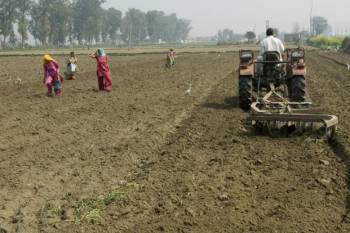NEW DELHI, 17 September 2024: Labor shortages in agriculture are becoming increasingly prevalent as rural-to-urban migration, changing demographics, and economic shifts impact the availability of farm workers.
This shortage threatens productivity and the sustainability of farming operations. To address these challenges, the agricultural sector is turning to automation and skill development as key solutions. This article explores the causes of labor shortages, the potential of automation, and the role of skill development in mitigating these issues.
Causes of Labor Shortages in Agriculture
- Rural-to-Urban Migration
As people migrate from rural areas to cities in search of better economic opportunities, the rural labor force is shrinking. Young people, in particular, are leaving agricultural work for more attractive job prospects in urban areas, exacerbating labor shortages.
- Aging Workforce
The agricultural sector is experiencing an aging workforce, with many farmers and agricultural workers nearing retirement age. The younger generation’s reluctance to pursue farming as a career further contributes to the shortage of available labor.
- Economic Shifts
Economic development and rising incomes often lead to a shift in career preferences. As economies grow, agricultural work may be perceived as less desirable compared to other sectors, leading to a reduction in the number of people willing to work in agriculture.
- Low Wages and Poor Working Conditions
Low wages and challenging working conditions can deter individuals from pursuing agricultural labor. Inadequate compensation and difficult work environments can make agricultural jobs less attractive compared to other employment opportunities.
- Seasonal and Temporary Nature of Work
Agricultural work is often seasonal and temporary, which can be less appealing to workers seeking stable, year-round employment. The cyclical nature of agricultural tasks creates fluctuations in labor demand, complicating recruitment and retention.
Exploring Automation in Agriculture
- Mechanization of Farm Operations
Automation and mechanization involve using machinery and technology to perform tasks traditionally done by hand. Key areas of mechanization include planting, harvesting, irrigation, and soil preparation. Automated machinery can increase efficiency, reduce labor requirements, and improve productivity.
- Harvesting Robots: Advanced harvesting robots are designed to pick fruits and vegetables with precision and speed. These robots can work continuously, reducing the need for manual labor during peak harvest seasons.
- Automated Tractors: Modern tractors equipped with GPS and autonomous technology can perform tasks such as plowing, planting, and fertilizing with minimal human intervention. These machines enhance precision and efficiency in farm operations.
- Precision Agriculture
Precision agriculture uses technology to optimize farming practices and resource use. Technologies such as drones, sensors, and data analytics enable farmers to monitor crop health, manage soil conditions, and apply inputs more effectively.
- Drones: Drones equipped with cameras and sensors can capture aerial imagery and data on crop health, irrigation needs, and pest activity. This information helps farmers make informed decisions and manage resources efficiently.
- Soil Sensors: Soil sensors provide real-time data on soil moisture, temperature, and nutrient levels. This information helps farmers tailor irrigation and fertilization practices to specific crop needs.
- Automation in Livestock Management
Automation is also transforming livestock management. Technologies such as automated feeding systems, milking robots, and health monitoring devices improve efficiency and reduce labor requirements.
- Milking Robots: Milking robots automate the milking process, allowing dairy farmers to increase milk production and reduce labor. These systems can also monitor udder health and milk quality.
- Automated Feeding Systems: Automated feeding systems distribute feed to livestock at scheduled intervals, reducing the need for manual labor and ensuring consistent nutrition.
- Challenges and Considerations
While automation offers numerous benefits, there are challenges to consider, including high initial costs, technical complexity, and the need for ongoing maintenance. Additionally, the adoption of automation requires training and skill development for operators and technicians.
The Role of Skill Development
- Training for Technology Adoption
As automation becomes more prevalent, there is a growing need for training programs to equip farmers and agricultural workers with the skills required to operate and maintain new technologies. Skill development programs can help individuals understand and effectively use machinery, software, and data analytics tools.
- Technical Training: Training programs should focus on technical skills related to the operation and maintenance of automated machinery. This includes understanding machinery functions, troubleshooting issues, and performing routine maintenance.
- Digital Literacy: As precision agriculture relies on data and digital tools, enhancing digital literacy among farmers is essential. Training programs should cover data analysis, software use, and interpretation of technological outputs.
- Educational Programs and Workshops
Educational programs and workshops can provide valuable knowledge and practical skills related to modern agricultural practices. These programs can be offered through agricultural extension services, vocational training centers, and partnerships with industry stakeholders.
- Extension Services: Agricultural extension services can provide on-the-ground support and training for farmers. Extension agents can offer workshops, demonstrations, and hands-on training in new technologies and practices.
- Vocational Training: Vocational training centers can offer specialized programs focused on agricultural technology and machinery. These programs can prepare individuals for careers in agriculture and technology.
- Promoting STEM Education
Encouraging students to pursue science, technology, engineering, and mathematics (STEM) education can help address the skills gap in agriculture. STEM education can prepare future generations for careers in agricultural technology and innovation.
- Scholarships and Incentives: Providing scholarships and incentives for students pursuing degrees in agricultural science and technology can encourage more young people to enter the field.
- Industry Partnerships: Partnerships between educational institutions and agricultural technology companies can provide students with practical experience and exposure to cutting-edge technologies.
- Fostering Innovation and Entrepreneurship
Supporting innovation and entrepreneurship in agriculture can lead to the development of new technologies and solutions. Encouraging startups and research initiatives focused on agricultural technology can drive advancements and create new opportunities for skilled professionals.
- Innovation Hubs: Establishing innovation hubs and incubators can support the development of new agricultural technologies and solutions. These hubs can provide resources, mentorship, and funding for entrepreneurs and researchers.
- Research and Development: Investing in research and development can drive technological advancements and create new opportunities for skill development in agriculture.
Case Studies and Success Stories
- The Case of Precision Farming in Punjab
Farmers in Punjab have adopted precision farming techniques, including soil sensors and drones, to optimize resource use and improve crop yields. Training programs and support from agricultural extension services have facilitated the successful adoption of these technologies.
- The Role of the Agricultural Technology Training Institute (ATTI)
The Agricultural Technology Training Institute (ATTI) in Karnataka offers training programs for farmers and technicians on the operation and maintenance of automated machinery. The institute has helped enhance the skills of individuals in the region, improving the efficiency of local farms.
- The Use of Milking Robots in Gujarat
Dairy farms in Gujarat have implemented milking robots to automate the milking process. This technology has increased milk production and reduced labor requirements, while training programs have equipped farmers with the skills needed to operate and maintain the robots.
Labor shortages in agriculture present significant challenges, but automation and skill development offer promising solutions. By embracing technological advancements and investing in training and education, the agricultural sector can address labor shortages, improve productivity, and ensure the sustainability of farming operations.
Supporting farmers in adopting new technologies, enhancing their skills, and fostering innovation will be crucial for overcoming labor challenges and building a resilient agricultural sector for the future.























